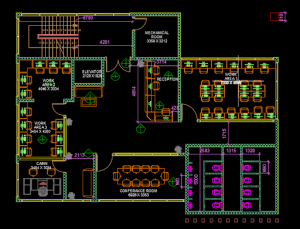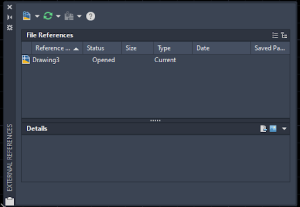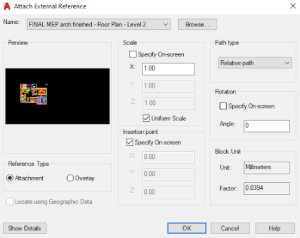EXTERNAL REFRANCE (XREF) –
It is impossible for anyone working in the technical industry not to hear about AutoCAD. Architects, interior designers, engineers, and many other professionals use AutoCAD in their daily commute.
AutoCAD was a pioneer in the CAD industry and has dominated it with good features and innovations over the years. One such feature, which we will look at today, is the “xref” feature.
In AutoCAD, xref is the acronym for “external indic ators”. As the name suggests, the xref feature allows you to attach external references to your drawing. External references may be in the form of other drawings, PDFs, images, point cloud data, and so on. The xref feature acts as a kind of overlay on your drawings; it is not part of your drawing.

Consider a multi-level construction site that we have drawn in AutoCAD. The building area is the main painting, and on the floor are the second paintings. Therefore, once you have completed the main sketch of the site, you can use it as a reference for additional floor plans. No need to copy-paste the site plan each time in the floor plan diagram. Do not simply attach it as an external reference and overlay it in your drawing. You can then use it as a reference to place your various floors.
For Free, Demo classes Call: +91 9172939402
Registration Link: Click Here!
In this article, we will look at more details about the xref feature, including its benefits, types, and how you can apply them to your drawings.
WHY USE THEM
Modern home planning may require several repetitions of certain elements
Using the external reference feature in AutoCAD can improve your overall workflow. However, before proceeding, it is important to understand why you would like to add xrefs in the first place. Here are three reasons:
- Multiple users: As mentioned earlier, the external reference covers the main drawing in your workspace. This allows multiple users to work on one project at a time. For example, a single user drawing a lamp can start it based on a floor plan reference. Another user in charge of the furniture can draw his or her drawings with reference to the floor plan.

- High productivity: Since many users can work on one project at a time, this leads to increased productivity. To continue our example, we can use a single site program as a reference for drawing floor plans. So, everyone gets their own drawing category.
- Consistency: Whenever you separate a project from multiple people, maintaining consistency throughout the project is important. When everyone working on projects uses the same drawing, it eliminates the possibility of errors, i.e. any changes made to the main drawing are immediately updated in the hosting drawings.
For Free, Demo classes Call: +91 9172939402
Registration Link: Click Here!
TYPES
Understanding the types of external indicators can help you improve your AutoCAD skills.
There are various external formats that you can use in your drawings. You can use images in almost all common formats like JPG and PNG. You can also import drawings in DWG or DWF format. You can even refer to PDFs and index cloud data.
Although there is some flexibility in the formats used for external indicators, there are two basic types of external indicators in AutoCAD: overlay and attachment. Let’s take a closer look.
Overlay
In this type of external reference, AutoCAD covers the drawing in the host diagram. This means that the external index does not become part of your drawing; it remains completely different from your drawing and is only used as a reference.
For example, suppose you use a large domain program as a reference for your subdomain program. And someone else is using your floor plan as a reference for each of their drawings. Therefore, they do not have to use the site plan for their drawings, they just need your floor plans. Thus, the external indicator may be overlay. This way, you can have reference when you work with it while someone else only has access to your drawing and not an external reference attached.

Attachments
Unlike in the past, sometimes each person needs a whole drawing to do their job. This is where you use the external reference as an attachment. Allows everyone involved in a project to view all external indicators in all drawings.
HOW TO USE THEM
Now that we know what and why, let’s look at how we can actually use xref in AutoCAD. The good news is to use external indicators as easy as you find. Let us consider two basic methods:
Ribbon Route
- In the model space, at the top, make sure the AutoCAD ribbon is visible. Among the various options in the ribbon space, click on the “Insert” tab and then click on the “Paste” option.
- Select the file type and file location of your drawing.
- Once you have selected this, a new window appears with customization options for your external reference.
- Here you can preview the drawing, set an external reference scale, select an external reference type, and more. You can leave them automatically for now. Then, click “OK”.
- Select the input point with the left click, and you can now use the drawing as an external reference in your model space. That’s all!
Command Mode
Well, if the above steps seem a bit too long for you, you can always use AutoCAD instructions. Just type the command “XREF” into the command bar, and a new window will appear with all the tools you need.
PROPERTIES
You can customize xrefs the way you like too
Now that we’ve looked at how to incorporate xref into your drawing, let’s re-understand some of its features in the model space.
Once you have installed the external reference in your model area, you can access how you want to apply them to AutoCAD drawings. On the Insert tab, you can access External Reference features by clicking the small arrow next to it.
This opens a new window. Here, you can view your drawing and the external reference drawing you used. Right-click on the outline and you’ll be given some options.
- Open: Opens the reference drawing, and if you can access it, you can edit it.
- Detach: Removes external reference to your drawing. This removes the reference drawing from the host drawing.
- Unload: Temporarily introducing an external reference to your drawing. Unlike the uninstall option, which removes the reference entirely, uploading only temporarily disables the external reference.
- Reload: Add an external reference to your drawing if you have downloaded it. You can also use this to show any changes made to the main drawing.
- Bind: Allows you to choose if you want to keep the actual properties for an external reference. In the Bind box, there are two options:
o Bind: Maintains the original layer structures, any colors, and the blocking properties of the reference drawing are similar to the host drawing.
o Insert: Removes any features of the reference drawing. In this way, all the structures are like a reference and a host drawing.
For Free, Demo classes Call: +91 9172939402
Registration Link: Click Here!
FINAL THOUGHTS
AutoCAD can be used to draw almost anything you can imagine!
External references are a good feature you can use in your drawings. It allows you to be more productive, helps maintain consistency especially when working in a team, and can improve your drawing quality.
Additionally, AutoCAD 2021 has some built-in instructions that help improve your user experience while using the xref feature.
Author:-
Rohan Vairagar
| SevenMentor Pvt Ltd.
© Copyright 2021 | Sevenmentor Pvt Ltd.

